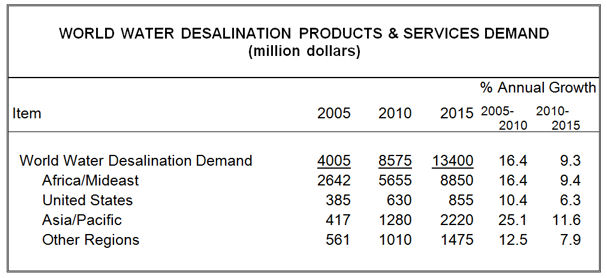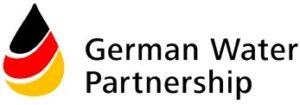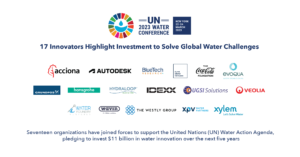World Demand for Water Desalination Products and Services to Reach $13.4 Billion in 2015
World demand for water desalination products and services is projected to increase 9.3 percent annually to $13.4 billion in 2015.

Although the global economic downturn has slowed growth in new desalination capacity from the torrid pace of the 2005-2010 period, gains will still be strong in nearly every significant desalination market -- but particularly in the Asia/Pacific region.
These and other trends are presented in World Water Desalination, a new study from The Freedonia Group, Inc., a Cleveland-based industry market research firm.
The Middle East and North Africa account for about two-thirds of global demand for desalination products and services. The largest desalination markets in the region -- Saudi Arabia, the United Arab Emirates and Kuwait -- depend on desalination for a large share of their water supply, and in some cases nearly all of their drinking water needs. Traditionally, these areas have relied on thermal techniques, particularly multi-stage flash (MSF) distillation. Many of the largest plants use integrated water and power plant (IWPP) models, in which desalination equipment is powered by waste heat from a power plant. In the coming years, reverse osmosis (RO) and other membrane-based technologies are expected to increase their share of the market in the Africa/Mideast region, especially in countries with water shortages that also lack abundant domestic energy supplies, such as Algeria and Israel.
Other areas in which desalination is expected to continue to register favorable growth have not always been challenged by severe shortages of fresh water. In the US -- the largest market outside the Middle East -- population growth and economic development in areas with insufficient water supplies (or brackish water supplies) will boost demand for membrane elements and other products used in membrane systems. In California, the traditional approach of importing water from elsewhere has become less feasible due to its high costs and growing demand for water in areas that had once had substantial water surpluses. In the Asia/Pacific region, much of the growth going forward will be in China and India, countries with large water supplies in absolute terms, but severe problems with water quality caused by centuries of negligence. In Europe, Spain is the largest desalination market, due to the continued economic development in the country, much of which has been in arid regions. Other countries, such as the UK, have installed desalination capacity that is intended to operate only in times of drought or other shortages.
Picture: © 2011 by The Freedonia Group, Inc.
Source: Freedonia Group







